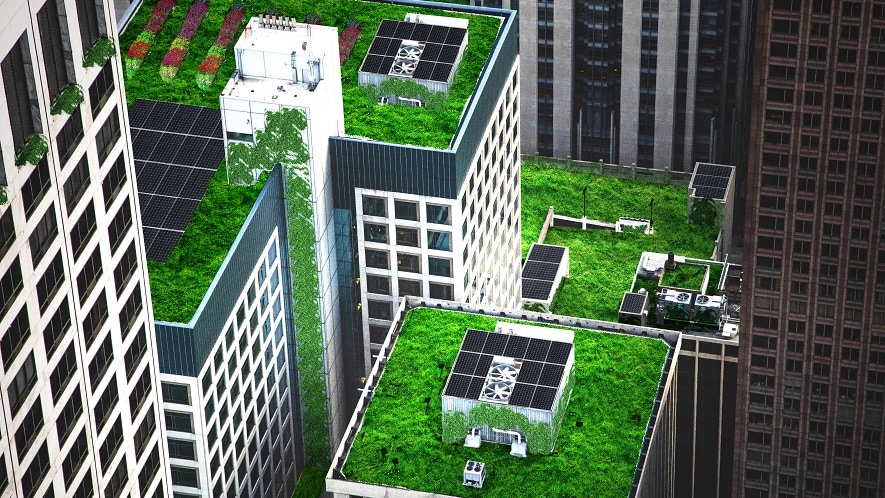ESG initiatives for sustainable value creation and positive environmental outcomes was originally published on PWC
Summary: A real estate sector that emphasizes sustainable development and operation can play a significant role in reducing greenhouse gas (GHG) emissions and help slow climate change, with the added benefit of increasing asset valuations.
With almost 40% of global carbon dioxide emissions arising from the real estate sector, any business with four walls is compelled to assess how ESG initiatives fit into its business model.
There’s a global imperative and mounting pressure from regulators and tenants to develop, operate and retrofit buildings to be sustainable. There could be upfront costs to becoming green, but also many benefits. By reducing operating costs through sustainable strategies, real estate owners and investors could increase their profits and build a portfolio that grows in value while contributing to a healthier planet.

Implementing a sustainable real estate strategy
Real estate stakeholders can integrate sustainable measures into internal processes, combating the impacts of climate change from within.
Implementing sustainable practices goes beyond regulatory compliance. It requires a deep understanding of the short and long-term impacts on your business. By taking a strategic and integrated approach to ESG initiatives, you can create a platform that not only meets regulatory requirements but also helps drive positive change, creating a sustainable future for your company and the environment.
With the right skills and resources, you can revolutionize your real assets and become a sustainable leader.
Staying ahead on compliance
Regulatory requirements are critical to moving sustainable real estate ahead. The forthcoming SEC climate disclosure rules and existing reporting requirements will help drive the sector toward a more sustainable future, following the EU and other global markets.
- The regulatory climate is rapidly evolving — from SEC’s proposals in the US and CSRD regulations in the EU — around energy reporting requirements.
- Several cities and states have taken important steps to longer-term decarbonization goals, like New York’s Local Law 97, that makes sure buildings report their annual building energy emissions and consumption — as well as year-over-year data.
- Real estate owners and investors can comply with carbon emissions reduction by sourcing material and products from low carbon-producing suppliers, virtual power purchase agreements (VPPAs) or through use of on-site solar energy systems.
- Operational energy efficiency with efficient lighting and HVAC systems could be an integral factor in disclosing investments in capital projects that support transition to renewable energy.
Creating value and managing risk through sustainability
Embedding sustainability into real estate — whether beginning in development or through rehabbing — could reap multiple benefits, including cost reductions that result in higher ROI, attracting tenants and investors and reducing risks associated with climate events.
- Sustainable buildings with cost-optimal operations are often cleaner, healthier and often less expensive to operate. Those cost-savings can be passed on to investors, tenants or your own bottom line.
- Sustainable measures often require upfront capital investment. Yet introducing sustainable operations could expedite the ROI investors are looking for.
- Sustainable features in buildings and across real estate portfolios, like energy efficient lighting and appliances, green roofs or on-site solar, can attract more tenants and result in sustained revenues with higher premiums.
Delivering on real estate investor demands
Real estate investors prioritize value creation and ROI, but a demographic shift shows climate change is a pressing concern; many are considering the environmental impact of their investments. In addition, more investors have funds earmarked for sustainable development, increasing the demand for green real estate projects.
Meantime, there’s also a growing understanding among building owners that real assets need protection from climate events. So leveraging ESG strategies in the real estate sector comes with rewards:
- Sustainable real estate does not only benefit the environment but also offers financial advantages, like tax incentives, for building owners and operators.
- Sustainable development can attract more international investors who need to place ESG-marked capital.
- Investors understand the ROI potential that sustainability can bring and they’re interested in tapping into it.
- Many real estate investors and business owners of real assets are incorporating into ROI projections the potential effect on valuations from climate events. Embedding and screening for sustainability parameters during the investment process can help mitigate the adverse financial impacts of climate risk.
Gaining a competitive advantage through decarbonization goals
For real estate owners and investors, company operations can be complex and the stakeholder base is often varied across business sectors. Yet, many boards, senior management, employees and customers are interested in decarbonization goals.
- Embedded strategies for decarbonization can attract and retain investors, talent and customers who want to help address climate change and support decarbonization goals — providing a competitive advantage in the marketplace.
- Operations within real assets can be a relatively easy starting point for sustainability measures that help promote the well-being of occupants and reduce Scope 1 and Scope 2 emissions.

Where to go from here
By prioritizing sustainable building and operations — whether in the development phase or through rehabbing existing real assets — owners and investors can help mitigate GHG emissions, as well as reduce energy costs and create value in a changing environment.
Ultimately, taking advantage of sustainable opportunities can help companies and investors gain a competitive advantage in the marketplace while simultaneously reducing climate risk.

